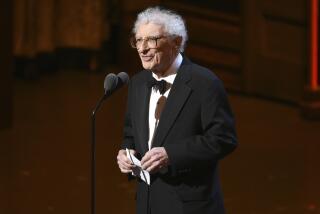Douglas Herrick, 82; on a Whim He Created ‘Jackalope’
- Share via
Douglas Herrick, creator of the “jackalope” -- that curious critter with a jack rabbit’s body and an antelope’s antlers that could turn downright vicious when threatened yet sing a gentle tenor along with the best of the campfire cowboys -- has died. He was 82.
Herrick died Jan. 3 of bone and lung cancer at the Central Wyoming Hospice Home in Casper, Wyo.
Sometime back in the 1930s, the Herrick brothers -- Douglas and Ralph, who studied taxidermy by mail order as teenagers -- went hunting. Returning home and in a hurry to get to dinner, they tossed their hapless jack rabbit kill into the taxidermy shop.
The carcass slid right up to a pair of deer antlers, and Douglas Herrick’s eyes suddenly lighted up.
“Let’s mount it the way it is!” he said, and a legend was born -- or at least given form.
Jackalopes, thanks to the Herrick brothers, have taken their place in modern mythology right alongside Bigfoot and the Loch Ness monster. Believers claim the hairy horned hoppers have been around just as long as those treasures of the Northwest and Scotland.
As “proof” of the jackalope’s presence now and in earlier centuries, they cite:
A 16th century painting of a horned rabbit (although scientists suspect the pictured deformity was caused by a rabbit virus).
A mention by Buddha of a horned rabbit (without adding that he doubted any existed).
Oft-told tales of a trapper first sighting a jackalope in Wyoming in 1829 (who can say?).
Fact or fiction, legend or lark, the jackalope the Herricks stuffed and mounted gave their native Douglas, Wyo., a reason to be.
Before discovery of uranium, coal, oil and natural gas doubled the town’s population to about 7,500 in the mid-1970s, Douglas specialized in selling jackalope souvenirs. The taxidermist Herricks, equipped with plenty of deer and antelope horn tips and bunny bodies, fed the demand for the stuffed and mounted trophies. Tens of thousands have been sold.
That first jackalope they put together after the inspirational hunting trip in the 1930s was sold for $10 to Roy Ball, who installed it proudly in the town’s Bonte Hotel. The mounted horned rabbit head was stolen in 1977, proving the proliferating popularity of the must-have totem of Wyoming and the West.
The town of Douglas erected an 8-foot-tall statue of the jackalope. Later, proud city fathers added a 13-foot-tall jackalope cutout on a nearby hillside and placed jackalope images on park benches, firetrucks, whatever.
Acknowledging the animal’s purported propensity to attack ferociously anything that threatened it, the city also posted warning signs: “Watch out for the jackalope.”
The Douglas Chamber of Commerce has issued thousands of jackalope hunting licenses to eager tourists, despite rules specifying that the hunter cannot have an IQ higher than 72 and can hunt only between midnight and 2 a.m. each June 31.
Tourist shop clerks in Douglas told and retold tales of cowboys who remembered harmonious jackalopes joining their nightly campfire songs. Mesmerized visitors -- one Californian reportedly wanted to start a jackalope breeding ranch -- have rarely left Douglas without buying jackalope postcards and trinkets. Only a few concoctions -- canned jackalope milk for one -- failed to gain a following.
The state of Wyoming trademarked the jackalope name in 1965. Twenty years later, Gov. Ed Herschler, crediting Douglas Herrick with the animal’s creation, designated Wyoming the jackalope’s official stamping grounds. A legislative attempt was made in 2001 to name the jackalope the state’s official mythical creature, but it failed.
Herrick, the acknowledged creator, made only about 1,000 or so horned rabbit trophies before going on to other things. His brother kept churning out jackalopes.
Douglas Eugene Herrick grew up on a ranch near Douglas and served as a tail gunner on a B-17 during World War II. He worked as a taxidermist until 1954, when he became a welder and pipe fitter for Amoco Refinery until his retirement in 1980.
A widower, Herrick is survived by two sons, two daughters, his brother and seven grandchildren.
More to Read
Sign up for Essential California
The most important California stories and recommendations in your inbox every morning.
You may occasionally receive promotional content from the Los Angeles Times.









